The Hydrothermal Alteration of the Cordón de Inacaliri Volcanic Complex in the Framework of the Hidden Geothermal Systems within the Pabelloncito Graben (Northern Chile)
Abstract
:1. Introduction
2. Geological Overview
3. Methodology
4. Results
4.1. Field Observations
4.2. Alteration Zone Mineralogy
4.3. Description of the Silica Deposits and the Mineralogical Transformation Processes
4.3.1. Superficial Massive Silica Deposits with Lateral Development as Surface Layers
4.3.2. Discontinuous Pinnacle-like Silica Deposits
4.3.3. Silica Deposits with Laterally Developed Coarse Stratification
5. Discussion
5.1. Types of Alteration and Formation Environment
- (i).
- kaolinite + alunite + opal-CT + anatase (domain 1);
- (ii).
- alunite + gypsum (domain 2);
- (iii).
- calcite + aragonite (domain 3);
- (iv).
- kaolinite + hematite + halloysite + smectite + I/S + illite (domain 4);
- (v).
- opal-CT (domain 5);
- (vi).
- quartz (domain 5).
5.1.1. Discharge Products Associated with Acid Fluids
Acid-Sulfate Alteration
Argillic Alteration
5.1.2. Discharge Products Associated with Neutral-Alkaline Fluids
5.2. Silica Deposits and Their Implications in the Reconstruction of the Subsurface Environment
- Precipitation of silicious sinters from alkaline spring discharges with microorganic activity, where the opal-A precipitation would have taken place. It currently appears as microcrystalline quartz in pinnacle-like silica deposits and silica deposits with coarse stratification.
- Early dissolution/growth and transformation processes. During these processes, the transformation from opal-A to microcrystalline quartz begins, and the coexistence of characteristic morphologies such as nano-microstructures and hexagonal microcrystals (Figure 12) emphasize a gradual and gradational process. The transformation rates vary among sinters because post-depositional conditions can accelerate or delay these processes. Although reports regarding the transformation rates of opal to quartz are in the order of thousands of years [26], the different step of degree of crystallinity of the silica deposits cannot be directly extrapolated as time indicators because this process also depends on factors such as altitude, temperature, pH and sulfur deposits [26].
- Alteration/precipitation in a steam-heated environment. At this period, the opal-CT in the silicified layer and the spread opal-CT with kaolinite-alunite-anatase in the friable layer would have formed and partially developed on sinter deposits.
- Dissolution/growth and transformation processes are accelerated by acidic fluids. The development of transformation processes in the steam-heated environment would have been enhanced by bringing to the transformation of opal-CT to opal-C to quartz, with a predominance of this last phase, but coexisting with the preceding phases, thus suggesting a gradual transformation. Different authors recognize that the replacement of silica occurs laterally in the form of patch textures on a millimetric scale [25,26,44,69]. Putnis [70] reported that a change from one silica polymorph to another, such as from tridymite to cristobalite or quartz, requires bond breakage and the creation of a new structure. This process leads to reconstructive transformations and provides a mechanism for extremely fine-scale intergrowths between the different polymorphs, allowing the co-existence of more than one silica phase at any given time. It is possible that the presence of acidic fluids accelerated the transformation processes in the sinter deposits. Experimental studies [26] show that condensed acid vapors favor the transformation rate, dissolving opal-A and generating quartz after 21 weeks. Both in steam-heated blanket and sinters (to a lesser extent), dissolution textures show interaction with acidic fluids (Figure 12C).
- Re-precipitation process associated with the present-day diffuse degassing fluxes. This actual event would be associated with dissolution and scarce and local formation of amorphous silica coupled with its transformation to opal-A, from acidic fluids. These variations in size and morphologies of the silica phases generate changes in the physical characteristics of the sinters. In general, there is an increase in density and a decrease in porosity with the development of mineralogical processes, although this tendency is still debated [44,71].
5.3. Hydrothermal, Structural and Paleoclimatic Interactions in the Geothermal Systems of Northern Chile
6. Conclusions
Author Contributions
Funding
Acknowledgments
Conflicts of Interest
References
- Aravena, D.; Muñoz, M.; Morata, D.; Lahsen, A.; Parada, M.A.; Dobson, P. Assessment of high enthalpy geotermal resources and promising areas of Chile. Geothermics 2016, 59, 1–13. [Google Scholar] [CrossRef] [Green Version]
- Mesa de Geotermia. Rol de la Geotermia en el Desarrollo de la Matriz Eléctrica Chilena; Ministerio de Energía: Santiago, Chile, 2018; Volume 66. Available online: http://www.minenergia.cl/mesa-geotermia (accessed on 3 July 2018).
- Sillitoe, R.H. Epithermal paleosurfaces. Miner. Deposita 2015, 50, 767–793. [Google Scholar] [CrossRef]
- Chang, Z.; Hedenquist, J.; White, N.C.; Cooke, D.; Roach, M.; Deyell, C.L.; Garcia, J.; Gemmell, J.B.; McKnight, S.; Cuison, A.L. Exploration Tools for Linked Porphyry and Epithermal Deposits: Example from the Mankayan Intrusion-Centered Cu-Au District, Luzon, Philippines. Econ. Geol. 2011, 106, 1365–1398. [Google Scholar] [CrossRef] [Green Version]
- Bobos, I.; Gomes, C. Mineralogy and Geochemistry (HFSE and REE) of the Present-Day Acid-Sulfate Types Alteration from the Active Hydrothermal System of Furnas Volcano São Miguel Island, The Azores Archipelago. Minerals 2021, 11, 355. [Google Scholar] [CrossRef]
- Sepúlveda, F.; Lahsen, A. Geothermal exploration in central southern Chile (33°–4°2S). Geotherm. Resour. Council Trans. 2003, 27, 635–638. [Google Scholar]
- Sepúlveda, F.; Lahsen, A.; Dorsch, K.; Palacios, C.; Bender, S. Geothermal Exploration in the Cordón Caulle Region, Southern Chile. In Proceedings of the World Geothermal Congress, Antalya, Turkey, 24–29 April 2005; pp. 24–29. [Google Scholar]
- Procesi, M. Geothermal Potential Evaluation for Northern Chile and Suggestions for New Energy Plans. Energies 2014, 7, 5444–5459. [Google Scholar] [CrossRef] [Green Version]
- Urzua, L.; Powell, T.; Cumming, W.B.; Dobson, P. Apacheta, a new geothermal prospect in northern Chile. Geotherm. Resour. Counc. 2002, 26, 65–69. [Google Scholar]
- Tassi, F.; Aguilera, F.; Darrah, T.; Vaselli, O.; Capaccioni, B.; Poreda, R.; Huertas, A.D. Fluid geochemistry of hydrothermal systems in the Arica-Parinacota, Tarapacá and Antofagasta regions (northern Chile). J. Volcanol. Geotherm. Res. 2010, 192, 1–15. [Google Scholar] [CrossRef]
- Maza, S.N.; Collo, G.; Morata, D.; Lizana, C.; Camus, E.; Taussi, M.; Renzulli, A.; Mattioli, M.; Godoy, B.; Alvear, B.; et al. Clay mineral associations in the clay cap from the Cerro Pabellón blind geothermal system, Andean Cordillera, Northern Chile. Clay Miner. 2018, 53, 117–141. [Google Scholar] [CrossRef]
- Maza, S.N.; Collo, G.; Morata, D.; Taussi, M.; Vidal, J.; Mattioli, M.; Renzulli, A. Active and fossil hydrothermal zones of the Apacheta volcano: Insights for the Cerro Pabellón hidden geothermal system (Northern Chile). Geothermics 2021, 96, 102206. [Google Scholar] [CrossRef]
- Inostroza, M.; Aguilera, F.; Menzies, A.; Layana, S.; González, C.; Ureta, G.; Sepúlveda, J.; Scheller, S.; Böehm, S.; Barraza, M.; et al. Deposition of metals and metalloids in the fumarolic fields of Guallatiri and Lastarria volcanoes, northern Chile. J. Volcanol. Geotherm. Res. 2020, 393, 106803. [Google Scholar] [CrossRef]
- Munoz-Saez, C.; Manga, M.; Hurwitz, S. Hydrothermal discharge from the El Tatio basin, Atacama, Chile. J. Volcanol. Geotherm. Res. 2018, 361, 25–35. [Google Scholar] [CrossRef] [Green Version]
- Hedenquist, J.W.; Arribas, A., Jr.; Gonzales-Urien, E. Exploration for epithermal gold deposits. Rev. Econ. Geol. 2000, 13, 245–277. [Google Scholar]
- Hedenquist, J.; Taran, Y.A. Modeling the Formation of Advanced Argillic Lithocaps: Volcanic Vapor Condensation Above Porphyry Intrusions. Econ. Geol. 2013, 108, 1523–1540. [Google Scholar] [CrossRef]
- Hedenquist, J.; Arribas, A. Exploration Implications of Multiple Formation Environments of Advanced Argillic Minerals. Econ. Geol. 2021, 35. [Google Scholar] [CrossRef]
- Bignall, G.; Browne, P. Surface hydrothermal alteration and evolution of the Te Kopia Thermal Area, New Zealand. Geothermics 1994, 23, 645–658. [Google Scholar] [CrossRef]
- Cumming, W. Geothermal resource conceptual models using surface exploration data. In Proceedings of the Thirty-Fourth Workshop on Geothermal Reservoir Engineering, Stanford, CA, USA, 9–11 February 2009. [Google Scholar]
- Longo, A.A.; Dilles, J.H.; Grunder, A.L.; Duncan, R. Evolution of Calc-Alkaline Volcanism and Associated Hydrothermal Gold Deposits at Yanacocha, Peru. Econ. Geol. 2010, 105, 1191–1241. [Google Scholar] [CrossRef]
- Chang, Z.; Hedenquist, J.W.; White, N.C.; Cooke, D.R.; Deyell, C.L.; Garcia, J. New tools for exploring lithocaps: Example from the Mankayan intrusion-centered Cu-Au district, Philippines. In Smart Science for Exploration and Mining, Proceedings of the Tenth Biennial SGA Meeting, Townsville, Australia, 17–20 August 2009; James Cook University School of Earth & Environmental Studies, Economic Geology Research Unit: Townsville, Australia, 2009; Volume 2, pp. 707–709. [Google Scholar]
- Jourdan, A.-L.V.; Mullis, J.; Ramseyer, K.; Spiers, C. Evidence of growth and sector zoning in hydrothermal quartz from Alpine veins. Eur. J. Miner. 2009, 21, 219–231. [Google Scholar] [CrossRef]
- Fournier, R.O.; Rowe, J.J. Estimation of underground temperatures from the silica content of water from hot springs and wet-steam wells. Am. J. Sci. 1966, 264, 685–697. [Google Scholar] [CrossRef]
- Fournier, R.O. The Behaviour of Silica in Hydrothermal Solutions. Rev. Econ. Geol. 1985, 2, 45–62. [Google Scholar]
- Lynne, B.Y.; Campbell, K.A.; Moore, J.N.; Browne, P.R.L. Diagenesis of 1900-year-old siliceous sinter (opal-A to quartz) at Opal Mound, Roosevelt Hot Springs, Utah, U.S.A. Sediment. Geol. 2005, 179, 249–278. [Google Scholar] [CrossRef]
- Lynne, B.Y.; Campbell, K.A.; Perry, R.S.; Browne, P.; Moore, J. Acceleration of sinter diagenesis in an active fumarole, Taupo volcanic zone, New Zealand. Geology 2006, 34, 749. [Google Scholar] [CrossRef]
- Lynne, B.Y. Siliceous sinter: An early exploration tool and direct link to a geothermal reservoir. In Proceedings of the Thirty-Eighth Workshop on Geothermal Reservoir Engineering Stanford University, Stanford, CA, USA, 11–13 February 2013; pp. 11–13. [Google Scholar]
- Taussi, M.; Nisi, B.; Vaselli, O.; Maza, S.; Morata, D.; Renzulli, A. Soil CO2 flux and temperature from a new geothermal area in the Cordón de Inacaliri Volcanic Complex (northern Chile). Geothermics 2021, 89, 101961. [Google Scholar] [CrossRef]
- Francis, P.W.; Rundle, C.C. Rates of production of the main magma types in the central Andes. GSA Bull. 1976, 87, 474. [Google Scholar] [CrossRef]
- Wörner, G.; Hammerschmidt, K.; Henjes-Kunst, F.; Lezaun, J.; Wilke, H. Geochronology (40Ar/39Ar, K-Ar and He-exposure ages) of Cenozoic magmatic rocks from northern Chile (18–22°S): Implications for magmatism and tectonic evolution of the central Andes. Rev. Geol. Chile 2000, 27, 205–240. [Google Scholar]
- Sellés, D.; Gardeweg, M. Geología del área Ascotán-Cerro Inacaliri, Región de Antofagasta. In Servicio Nacional de Geología y Minería, Carta Geológica de Chile; Serie Geología Básica No. 190 73; SERNAGEOMIN: Santiago, Chile, 2017. [Google Scholar] [CrossRef]
- Tibaldi, A.; Bonali, F. Contemporary recent extension and compression in the central Andes. J. Struct. Geol. 2018, 107, 73–92. [Google Scholar] [CrossRef]
- Tibaldi, A.; Rust, D.; Corazzato, C.; Merri, A. Setting the scene for self-destruction: From sheet intrusions to the structural evolution of rifted stratovolcanoes. Geosphere 2010, 6, 189–210. [Google Scholar] [CrossRef]
- Veloso, E.E.; Tardani, D.; Elizalde, D.; Godoy, B.; Sánchez-Alfaro, P.A.; Aron, F.; Reich, M.; Morata, D. A review of the geo-dynamic constraints on the development and evolution of geothermal systems in the Central Andean Volcanic Zone (18–28°Lat.S). Inter. Geol. Rev. 2019, 61, 1–25. [Google Scholar]
- Putz, H.; Brandenburg, K. Match!—Phase Analysis Using Powder Diffraction, Version 3.x; Crystal Impact—GbR: Bonn, Germany, 2021; Available online: https://www.crystalimpact.de/match (accessed on 3 March 2021).
- Hubbard, C.R.; Snyder, R.L. RIR—Measurement and Use in Quantitative XRD. Powder Diffr. 1988, 3, 74–77. [Google Scholar] [CrossRef] [Green Version]
- Jones, J.B.; Segnit, E.R. The nature of opal I. nomenclature and constituent phases. J. Geol. Soc. Aust. 1971, 18, 57–68. [Google Scholar] [CrossRef]
- Flörke, O.W.; Graetsch, H.; Martin, B.; Röller, K.; Wirth, R. Nomenclature of micro-and non-crystalline silica minerals, based on structure and microstructure. Neues Jahrbuch Mineralogie. Abhandlungen 1991, 163, 19–42. [Google Scholar]
- Graetsch, H. Structural characteristics of opaline and microcrystalline silica minerals. Silica 1994, 29, 209–232. [Google Scholar] [CrossRef]
- Lynne, B.Y.; Campbell, K.A. Diagenetic transformations (opal-A to quartz) of low- and mid-temperature microbial textures in siliceous hot-spring deposits, Taupo Volcanic Zone, New Zealand. Can. J. Earth Sci. 2003, 40, 1679–1696. [Google Scholar] [CrossRef]
- Lynne, B.Y.; Campbell, K. Morphologic and Mineralogic Transitions from Opal-A to Opal-CT in Low-Temperature Siliceous Sinter Diagenesis, Taupo Volcanic Zone, New Zealand. J. Sediment. Res. 2004, 74, 561–579. [Google Scholar] [CrossRef]
- Jones, B.; Renaut, R.W. Microstructural changes accompanying the opal-A to opal-CT transition: New evidence from the siliceous sinters of Geysir, Haukadalur, Iceland. Sedimentology 2007, 54, 921–948. [Google Scholar] [CrossRef]
- Herdianita, N.; Rodgers, K.A.; Browne, P.R. Routine instrumental procedures to characterise the mineralogy of modern and ancient silica sinters. Geothermics 2000, 29, 65–81. [Google Scholar] [CrossRef]
- Lynne, B.Y.; Campbell, K.; Moore, J.; Browne, P. Origin and evolution of the Steamboat Springs siliceous sinter deposit, Nevada, U.S.A. Sediment. Geol. 2008, 210, 111–131. [Google Scholar] [CrossRef]
- Moore, D.M.; Reynolds, R.C., Jr. X-ray Diffraction and the Identification and Analysis of Clay Minerals; Oxford University Press: Oxford, UK, 1997; p. 378. [Google Scholar]
- Aparicio, P.; Galán, E.; Ferrell, R.E. A new kaolinite order index based on XRD profile fitting. Clay Miner. 2006, 41, 811–817. [Google Scholar] [CrossRef]
- Sbrana, A.; Fulignati, P.; Marianelli, P.; Boyce, A.; Cecchetti, A. Exhumation of an active magmatic–hydrothermal system in a resurgent caldera environment: The example of Ischia (Italy). J. Geol. Soc. 2009, 166, 1061–1073. [Google Scholar] [CrossRef]
- Zimbelman, D.R.; Rye, R.O.; Breit, G.N. Origin of secondary sulfate minerals on active andesitic stratovolcanoes. Chem. Geol. 2005, 215, 37–60. [Google Scholar] [CrossRef] [Green Version]
- Africano, F.; Bernard, A. Acid alteration in the fumarolic environment of Usu volcano, Hokkaido, Japan. J. Volcanol. Geotherm. Res. 2000, 97, 475–495. [Google Scholar] [CrossRef]
- Adams, P.M.; Lynch, D.K.; Buckland, K.N.; Johnson, P.D.; Tratt, D.M. Sulfate mineralogy of fumaroles in the Salton Sea Geothermal Field, Imperial County, California. J. Volcanol. Geotherm. Res. 2017, 347, 15–43. [Google Scholar] [CrossRef]
- Piochi, M.; Mormone, A.; Balassone, G. Hydrothermal alteration environments and recent dynamics of the Ischia volcanic island (southern Italy): Insights from repeated field, mineralogical and geochemical surveys before and after the 2017 Casamicciola earthquake. J. Volcanol. Geotherm. Res. 2019, 376, 104–124. [Google Scholar] [CrossRef]
- Ercan, H.Ü.; Ece, Ö.I.; Schroeder, P.A.; Karacik, Z. Differentiating Styles of Alteration Within Kaolin-Alunite Hydrothermal Deposits of Çanakkale, NW Turkey. Clays Clay Miner. 2016, 64, 245–274. [Google Scholar] [CrossRef]
- Dill, H.G. Kaolin: Soil, rock and ore: From the mineral to the magmatic, sedimentary and metamorphic environments. Earth Sci. Rev. 2016, 161, 16–129. [Google Scholar] [CrossRef]
- Sillitoe, R.H.; Hedenquist, J.W. Linkages between volcanotectonic settings, ore fluid compositions and epithermal precious metal deposits. In Volcanic, Geothermal and Ore-forming Fluids: Rulers and Witnesses of Processes within the Earth; Simmons, S.F., Graham, I., Eds.; Society of Economic Geologists (SEG): Littleton, CO, USA, 2003; Volume 10, pp. 315–343. [Google Scholar]
- Pirajno, F. Hydrothermal Processes and Mineral Systems; Springer Science & Business Media: Berlin, Germany, 2008. [Google Scholar]
- Sillitoe, R.H. Porphyry Copper Systems. Econ. Geol. 2010, 105, 3–41. [Google Scholar] [CrossRef] [Green Version]
- Hedenquist, J.; Browne, P.R. The evolution of the Waiotapu geothermal system, New Zealand, based on the chemical and isotopic composition of its fluids, minerals and rocks. Geochim. Cosmochim. Acta 1989, 53, 2235–2257. [Google Scholar] [CrossRef]
- Hedenquist, J.W. Boiling and dilution in the shallow portion of the Waiotapu gethermal system, New Zealand. Geochim. Cosmochim. Acta. 1991, 55, 2753–2765. [Google Scholar] [CrossRef]
- Inoue, A. Formation of clay minerals in hydrothermal environments. In Origin and Mineralogy of Clays; Velde, B., Ed.; Springer: Berlin, Germany, 1995; pp. 268–329. [Google Scholar]
- Simmons, S.F.; Browne, P.R.L.; Arehart, G.B.; Hulston, J.R. Illite, illite-smectite and smectite occurrences in the Broad-lands-Ohaaki geothermal system and their implications for clay mineral geothermometry. Water Rock Interact. 1998, 9, 691–694. [Google Scholar]
- Patrier, P.; Beaufort, D.; Mas, A.; Traineau, H. Surficial clay assemblage associated with the hydrothermal activity of Bouillante (Guadeloupe, French West Indies). J. Volcanol. Geotherm. Res. 2003, 126, 143–156. [Google Scholar] [CrossRef]
- Stimac, J.; Goff, F.; Goff, C.J. Intrusion-Related Geothermal Systems. In The Encyclopedia of Volcanoes, 2nd ed.; Sigurdsson, H., Ed.; Academic Press: Amsterdam, The Netherlands, 2015; pp. 799–822. [Google Scholar] [CrossRef]
- White, N.C.; Hedenquist, J.W. Epithermal Gold Deposits: Styles, characteristics and exploration. SEG Discov. 1995, 1, 1–13. [Google Scholar] [CrossRef]
- Lynne, B.Y.; Campbell, K.; James, B.; Browne, P.R.L.; Moore, J. Tracking crystallinity in siliceous hot-spring deposits. Am. J. Sci. 2007, 307, 612–641. [Google Scholar] [CrossRef]
- Lynne, B.Y. Impact of three common post-depositional environmental settings on siliceous sinter diagenesis: An eight year experiment. J. Volcanol. Geotherm. Res. 2015, 292, 84–101. [Google Scholar] [CrossRef]
- White, D.; Thompson, G.; Sandberg, C. Rocks, structure, and geologic history of Steamboat Springs thermal area, Washoe County, Nevada. Geolog. Sur. Prof. Pap. 1964, 458-B, 1–63. [Google Scholar]
- Cady, S.L.; Farmer, J.D. Fossilization Processes in Siliceous Thermal Springs: Trends in Preservation Along Thermal Gradients. In Evolution of Hydrothermal Ecosystems on Earth (and Mars?), Proceedings of the CIBA Foundation Symposium, London, UK, 30 January–1 February 1996; Bock, G.R., Goode, J.A., Eds.; Wiley: Chichester, UK, 1996; Volume 202, pp. 150–173. [Google Scholar]
- Ritter, B.; Wennrich, V.; Medialdea, A.; Brill, D.; King, G.; Schneiderwind, S.; Niemann, K.; Fernández-Galego, E.; Diederich, J.; Rolf, C.; et al. Climatic fluctuations in the hyperarid core of the Atacama Desert during the past 215 ka. Sci. Rep. 2019, 9, 1–13. [Google Scholar] [CrossRef] [Green Version]
- Campbell, K.; Sannazzaro, K.; Rodgers, K.; Herdianita, N.; Browne, P. Sedimentary Facies and Mineralogy of the Late Pleistocene Umukuri Silica Sinter, Taupo Volcanic Zone, New Zealand. J. Sediment. Res. 2001, 71, 727–746. [Google Scholar] [CrossRef]
- Putnis, A. Introduction to Mineral Sciences; Cambridge University Press: Cambridge, UK, 1992. [Google Scholar]
- Herdianita, N.R.; Browne, P.R.L.; Rodgers, K.A.; Campbell, K.A. Mineralogical and textural changes accompanying ageing of silica sinter. Miner. Deposita 2000, 35, 48–62. [Google Scholar] [CrossRef]
- Román, N.; Reich, M.; Leisen, M.; Morata, D.; Barra, F.; Deditius, A. Geochemical and micro-textural fingerprints of boiling in pyrite. Geochim. Cosmochim. Acta 2019, 246, 60–85. [Google Scholar] [CrossRef]
- Reich, M.; Román, N.; Barra, F.; Morata, D. Silver-Rich Chalcopyrite from the Active Cerro Pabellón Geothermal System, Northern Chile. Minerals 2020, 10, 113. [Google Scholar] [CrossRef] [Green Version]
- Ward, D.J.; Cesta, J.M.; Galewsky, J.; Sagredo, E. Late Pleistocene glaciations of the arid subtropical Andes and new results from the Chajnantor Plateau, northern Chile. Quat. Sci. Rev. 2015, 128, 98–116. [Google Scholar] [CrossRef] [Green Version]
- Blard, P.-H.; Lave, J.; Farley, K.; Ramirez, V.; Jimenez, N.; Martin, L.; Charreau, J.; Tibari, B.; Fornari, M. Progressive glacial retreat in the Southern Altiplano (Uturuncu volcano, 22°S) between 65 and 14 ka constrained by cosmogenic 3He dating. Quat. Res. 2014, 82, 209–221. [Google Scholar] [CrossRef]
- Godoy, B.; Rodríguez, I.; Pizarro, M.; Rivera, G. Geomorphology, lithofacies, and block characteristics to determine the origin, and mobility, of a debris avalanche deposit at Apacheta-Aguilucho Volcanic Complex (AAVC), northern Chile. J. Volcanol. Geotherm. Res. 2017, 347, 136–148. [Google Scholar] [CrossRef]
- Morata, D.; Reich, M.; Muñoz-Saez, C.; Daniele, L.; Rivera, G.; Volpi, G.; Cecioni, M.; Guidetti, G.; Cappetti, G. Origin and age of fluids at the Cerro Pabellón Geothermal System, Northern Chile. In Proceedings of the 41st New Zealand Geothermal Workshop, Auckland, New Zealand, 25–27 November 2019. [Google Scholar]
- Slagter, S.; Reich, M.; Munoz-Saez, C.; Southon, J.; Morata, D.; Barra, F.; Gong, J.; Skok, J. Environmental controls on silica sinter formation revealed by radiocarbon dating. Geology 2019, 47, 330–334. [Google Scholar] [CrossRef]
- Taussi, M.; Nisi, B.; Pizarro, M.; Morata, D.; Veloso, E.A.; Volpi, G.; Vaselli, O.; Renzulli, A. Sealing capacity of clay-cap units above the Cerro Pabellón hidden geothermal system (northern Chile) derived by soil CO2 flux and temperature measurements. J. Volcanol. Geotherm. Res. 2019, 384, 1–14. [Google Scholar] [CrossRef]
- Collignon, M.; Cardellini, C.; Duprat-Oualid, S.; Øyvind, H.; Chiodini, G.; Vandemeulebrouck, J.; Gonzalez-Vidal, D.; Espinoza, A.; Tassara, A.; Ruch, J. Carbon dioxide diffuse emission at the Tolhuaca hydrothermal system (Chile) controlled by tectonics and topography. J. Volcanol. Geotherm. Res. 2021, 417, 107316. [Google Scholar] [CrossRef]
- Houston, J.; Hartley, A.J. The Central Andean west-slope rainshadow and its potential contribution to the origin of hyper-aridity in the Atacama desert. Int. J. Climatol. 2003, 23, 1453–1464. [Google Scholar] [CrossRef]
- Houston, J. Variability of precipitation in the Atacama Desert: Its causes and hydrological impact. Int. J. Climatol. 2006, 26, 2181–2198. [Google Scholar] [CrossRef]
- Rech, J.A.; Quade, J.; Betancourt, J.L. Late Quaternary paleohydrology of the central Atacama Desert (lat 22–24 S.), Chile. Geolog. Soc. Amer. Bul. 2002, 114, 334–348. [Google Scholar] [CrossRef]
- Renzulli, A.; Menna, M.; Tibaldi, A.; Flude, S. New data of surface geology, petrology and Ar-Ar geochronology of the Alti-plano-Puna Volcanic Complex (northern Chile) in the framework of future geothermal exploration. In Proceedings of the XI Congreso Geólogico Chileno, Antofagasta, Chile, 7–11 August 2006. [Google Scholar]
- Wilmeth, D.T.; Nabhan, S.; Myers, K.D.; Slagter, S.; Lalonde, S.V.; Sansjofre, P.; Homann, M.; Konhauser, K.O.; Munoz-Saez, C.; van Zuilen, M.A. Depositional evolution of an extinct sinter mound from source to outflow, El Tatio, Chile. Sediment. Geol. 2020, 406, 105726. [Google Scholar] [CrossRef]
- Taussi, M.; Godoy, B.; Piscaglia, F.; Morata, D.; Agostini, S.; Le Roux, P.; González-Maurel, O.; Gallmeyer, G.; Menzies, A.; Renzulli, A. The upper crustal magma plumbing system of the Pleistocene Apacheta-Aguilucho Volcanic Complex area (Altiplano-Puna, northern Chile) as inferred from the erupted lavas and their enclaves. J. Volcanol. Geotherm. Res. 2019, 373, 179–198. [Google Scholar] [CrossRef]

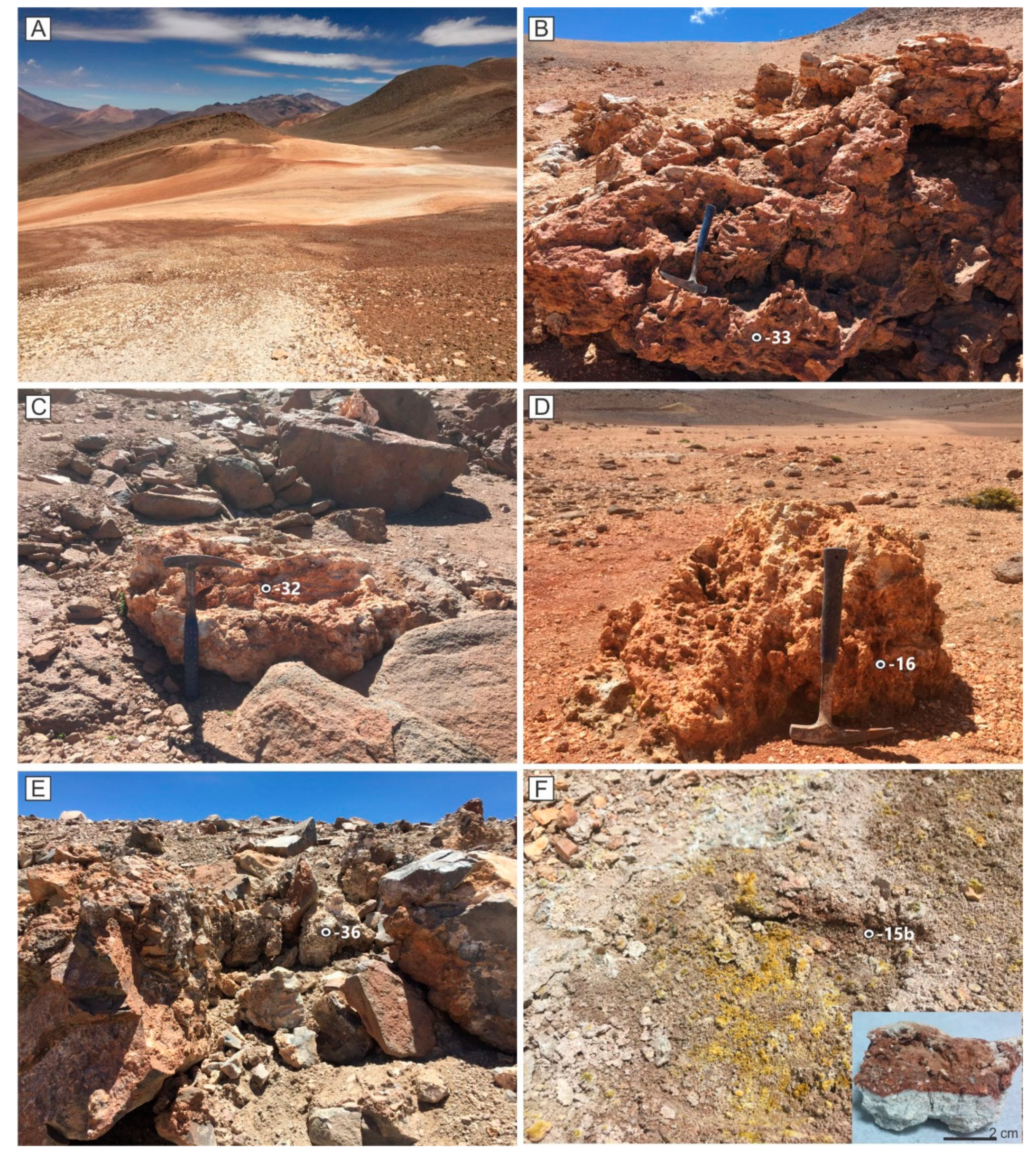

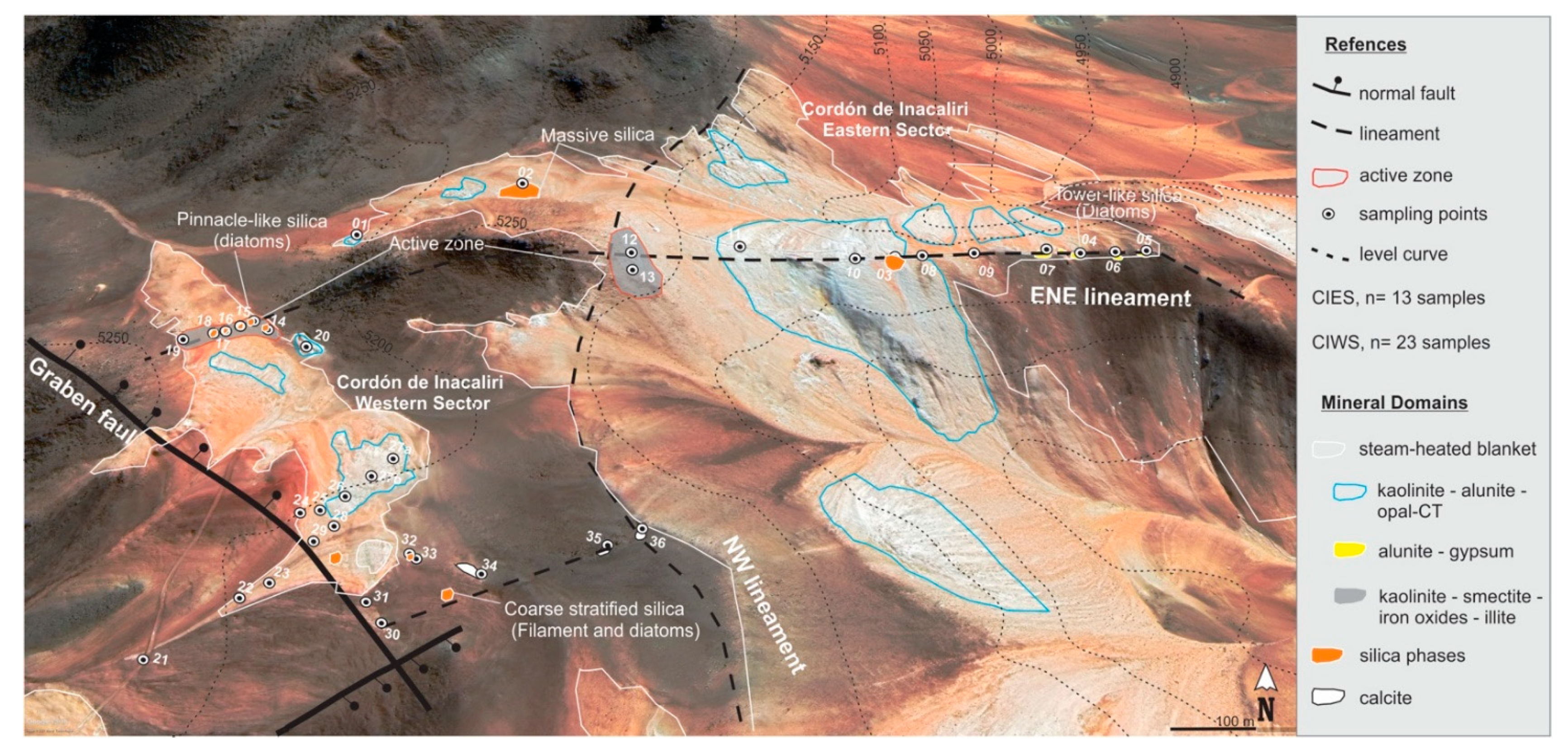
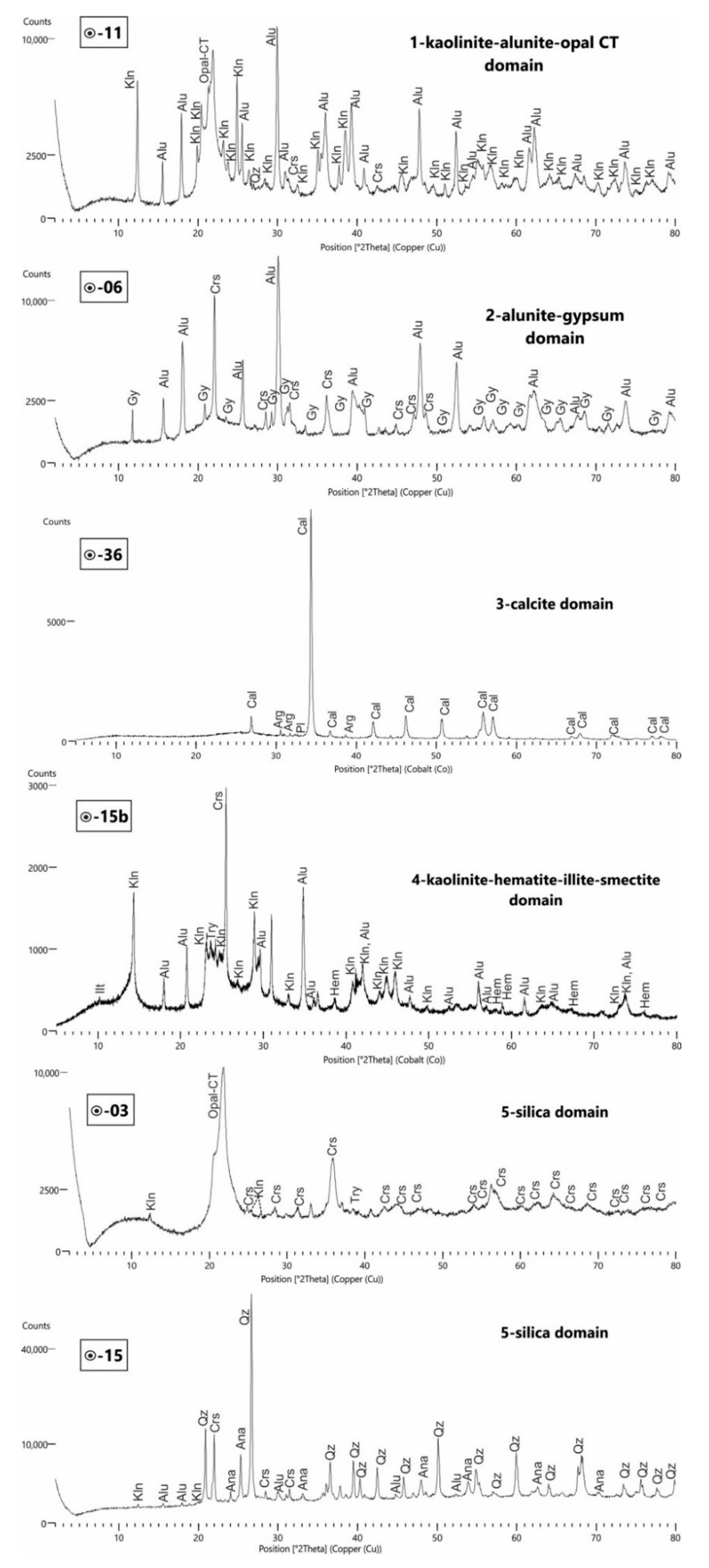



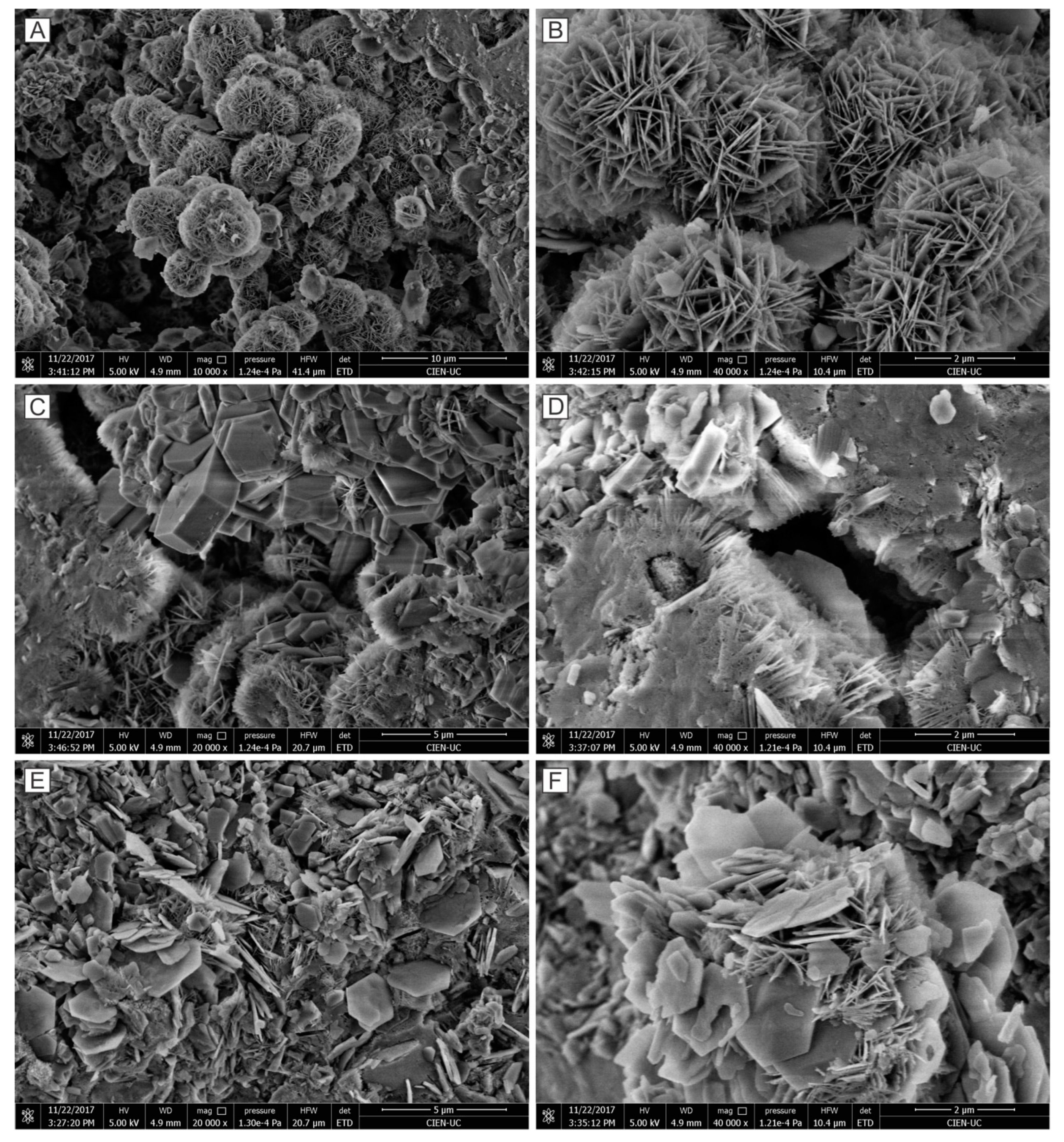

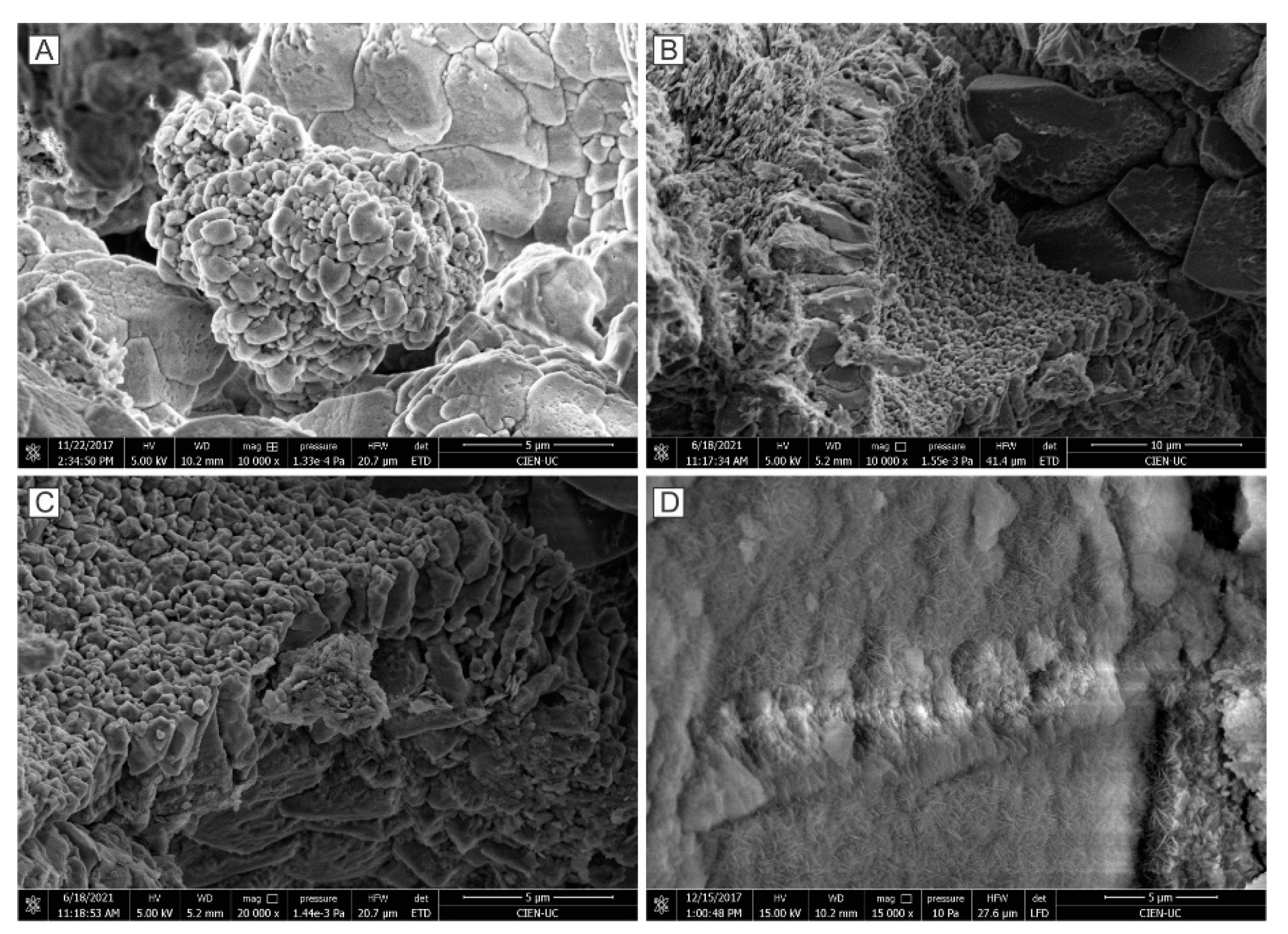


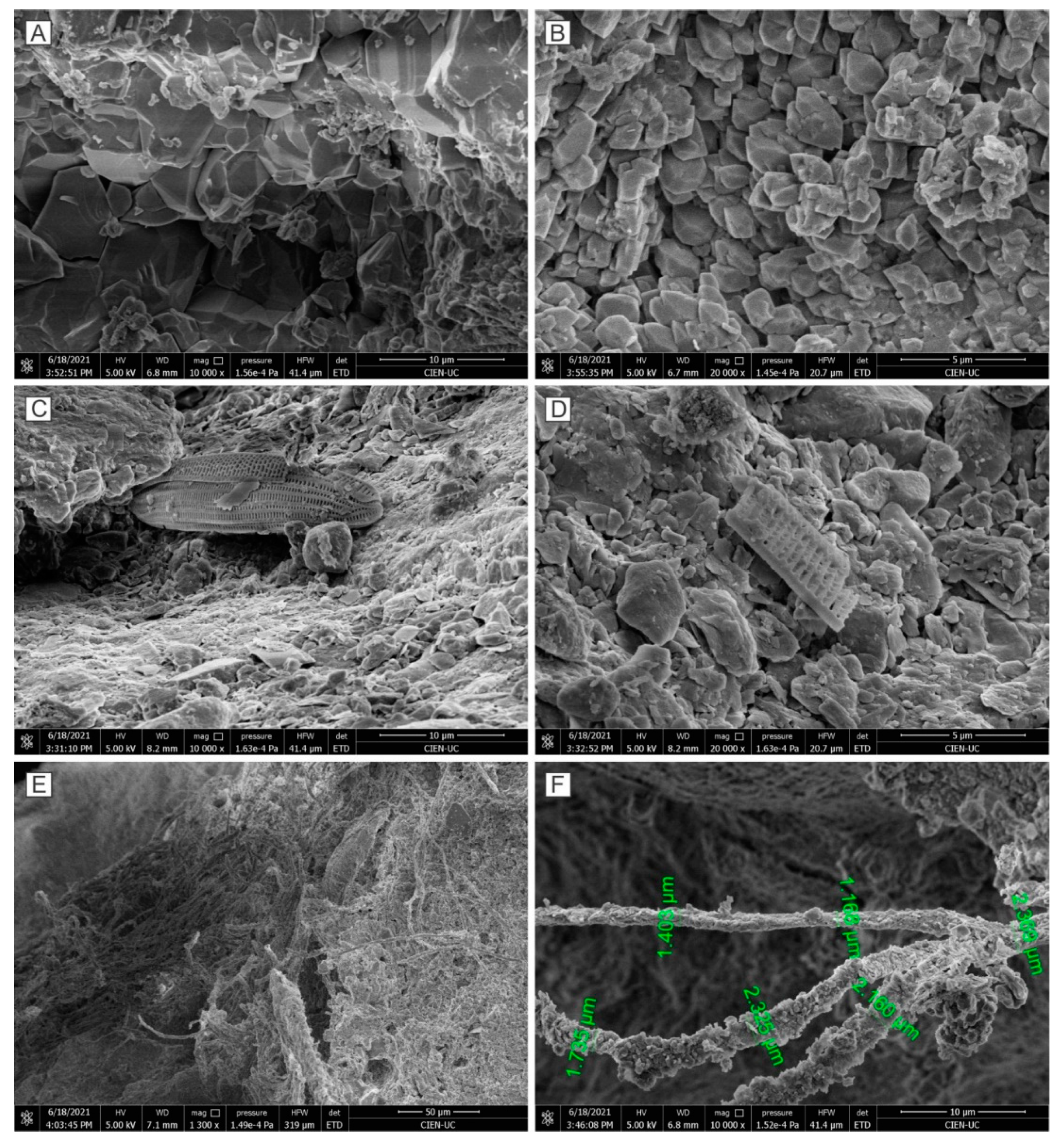
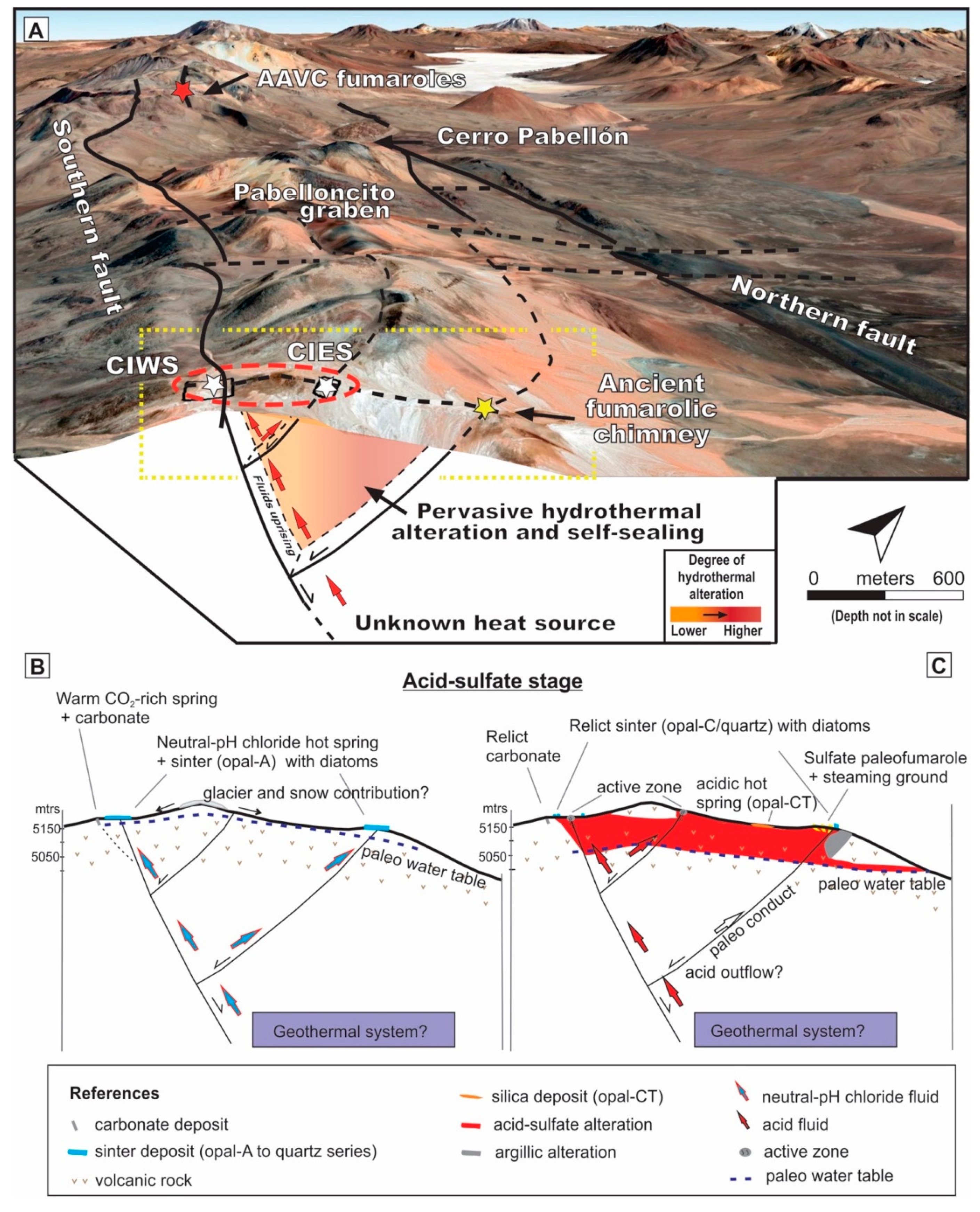
Publisher’s Note: MDPI stays neutral with regard to jurisdictional claims in published maps and institutional affiliations. |
© 2021 by the authors. Licensee MDPI, Basel, Switzerland. This article is an open access article distributed under the terms and conditions of the Creative Commons Attribution (CC BY) license (https://creativecommons.org/licenses/by/4.0/).
Share and Cite
Maza, S.N.; Collo, G.; Morata, D.; Cuña-Rodriguez, C.; Taussi, M.; Renzulli, A. The Hydrothermal Alteration of the Cordón de Inacaliri Volcanic Complex in the Framework of the Hidden Geothermal Systems within the Pabelloncito Graben (Northern Chile). Minerals 2021, 11, 1279. https://doi.org/10.3390/min11111279
Maza SN, Collo G, Morata D, Cuña-Rodriguez C, Taussi M, Renzulli A. The Hydrothermal Alteration of the Cordón de Inacaliri Volcanic Complex in the Framework of the Hidden Geothermal Systems within the Pabelloncito Graben (Northern Chile). Minerals. 2021; 11(11):1279. https://doi.org/10.3390/min11111279
Chicago/Turabian StyleMaza, Santiago Nicolás, Gilda Collo, Diego Morata, Carolina Cuña-Rodriguez, Marco Taussi, and Alberto Renzulli. 2021. "The Hydrothermal Alteration of the Cordón de Inacaliri Volcanic Complex in the Framework of the Hidden Geothermal Systems within the Pabelloncito Graben (Northern Chile)" Minerals 11, no. 11: 1279. https://doi.org/10.3390/min11111279
APA StyleMaza, S. N., Collo, G., Morata, D., Cuña-Rodriguez, C., Taussi, M., & Renzulli, A. (2021). The Hydrothermal Alteration of the Cordón de Inacaliri Volcanic Complex in the Framework of the Hidden Geothermal Systems within the Pabelloncito Graben (Northern Chile). Minerals, 11(11), 1279. https://doi.org/10.3390/min11111279






